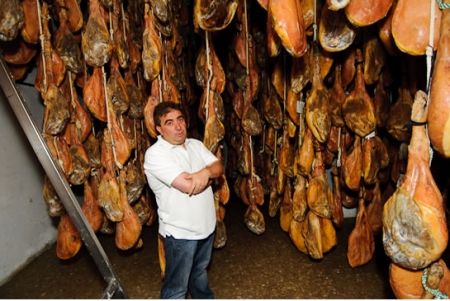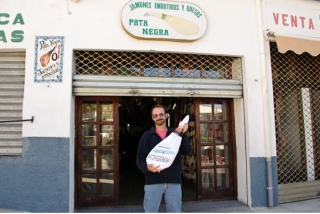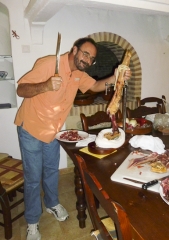Ann's Blog
Trevélez, Spain:
October 26, 2010
High times for ham-sters
If you followed our travels in An Embarrassment of Mangoes, you may recall that Steve has a thing for Serrano ham. The first time that Receta was in the Dominican Republic (1998), he wanted to buy a whole leg and hang it onboard so he could carve off a delicate slice or two whenever the urge struck. It was, in fact, my fault: I had recounted a story I'd read years earlier, about a Spanish bullfighter who carried a Serrano ham with him as he traveled from town to town and bullring to bullring. He'd hang it from the ceiling of each hotel room, so he could cut a slice whenever he wanted, the ultimate luxury for someone who grew up poor without enough to eat. Steve was captivated…and determined to have his own leg of luxury.
That time in the Dominican Republic, I managed to argue successfully against it. Even a champion eater like Steve couldn’t demolish a whole ham on his own, I pointed out, reminding him (not that he needed reminding) that I don’t eat the stuff. Besides, a cured pig’s leg swinging in the cabin of a boat that has a mezuzah mounted on the companionway? Even in a mixed marriage that was too much mixing for me.
So I knew I was looking for trouble when I booked us a night at a hotel in the village of Trevélez during our recent trip to Spain. Trevélez is Spain’s highest village, perched 1,476 metres up on the slopes of the Sierra Nevada, in the shadow of Spain’s highest mountain, Mulhacén. The cold, dry mountain air is excellent for curing hams, and Trevélez is renowned for its porky products. Its hams are said to be among the sweetest because the high elevation and low humidity mean less salting is required for the meat to dry and cure properly.
“Wouldn’t it be interesting to see how the hams are cured?” Steve said with his usual persuasive charm as we ate dinner at La Fragua, the restaurant of the inn where we were staying in Trevélez. (Fragua means “forge” in Spanish, and the La Fragua business card indeed shows a drawing of a man at a forge with blacksmith’s tongs and hammer making….sausages.) “We don’t have to buy a whole leg, of course; I’ll just buy a few slices, for a taste.” Steve was already heavily into the tasting at this point, having ordered an appetizer plate of sliced Trevélez ham, a (heavily porky) soup that was a specialty of the region, and a stewed pork knuckle (from a particularly large and meaty pig). He pronounced them all outstanding. (Meanwhile, I ate a Moorish lamb dish with almonds and dried fruit.)
So the next morning, I am charged with asking the hotel’s owner which of the many ham establishments in the village we should visit to see the curing process. He sends us (of course) to a relative.
Manolo Mendoza at Pata Negra is charming, patient, and obviously proud of his hams. Each one strung up by a hoof, they hang in darkness, row after row, from ceiling to knee-level, for at least a year and as long as two. Most of the legs have a white hoof, but some are black – the prized pata negra. The best of the best, Señor Mendoza explains, come from black-hooved pigs that feed on acorns in the fall before slaughter. (The price reflects the refinement of their diet.) The floor of the curing room – about the size of a basketball court – is slippery, slick with drips of fat from the hanging hams; the windows screened but not glassed; the room cool even in late September; and the smell (even to me) outrageously delicious.
You can guess how this story ends. It was inevitable – especially since we were on our way that very day to join 14 Toronto friends at a large country house in Andalucia that we had rented together for a week. Fourteen ham eaters. Counting Steve, 15. Nightly tapas, sandwiches, snacks – surely 15 people could demolish a whole leg in seven days, Steve argued persuasively.
And so Señor Mendoza picks out a jamón for Señor Steven, one that has been curing for 18 to 23 months. He hefts it to the counter, plunges a sharp toothpick-like “tester” deep into the meat to check its quality, withdraws it, sniffs approvingly, and then holds it up to Steve’s nose to make sure he concurs. He then slides it into a white cheesecloth-like “sock”, and presents it to Steve, along with a gift: a slicing knife.
Me? I buy a whole round of sheep’s cheese the size of a bowling ball. Nightly tapas, sandwiches, snacks — surely 15 people could demolish a whole cheese in seven days?
Right on both counts.
Back to topSign up to be notified by email when I post a new blog




